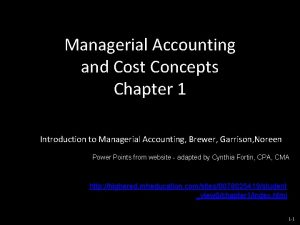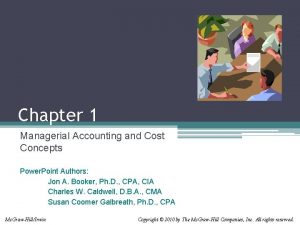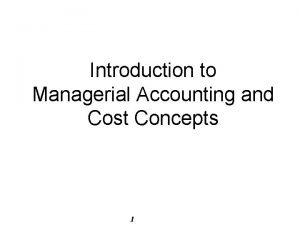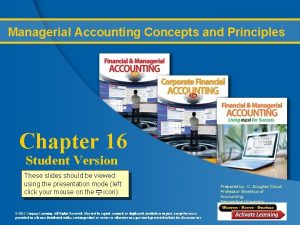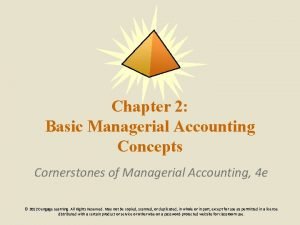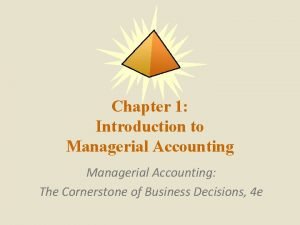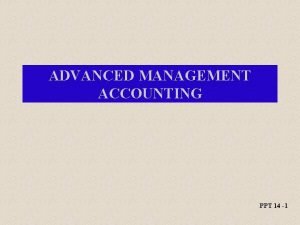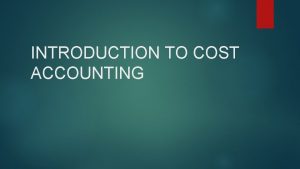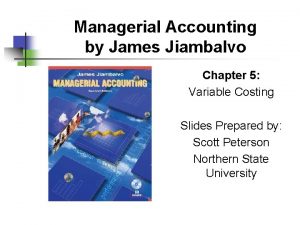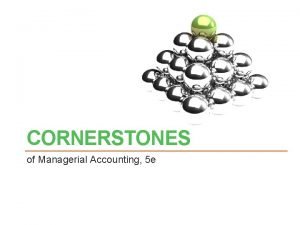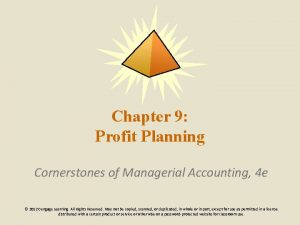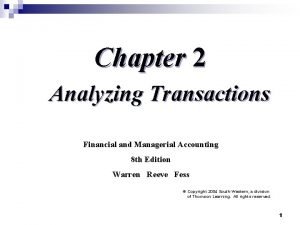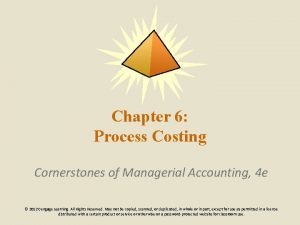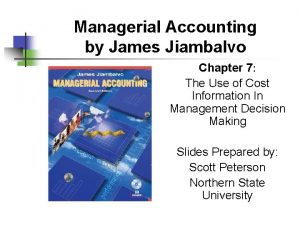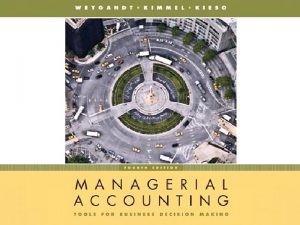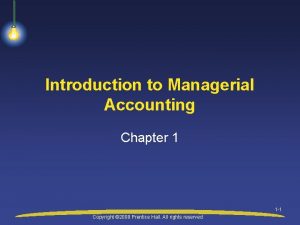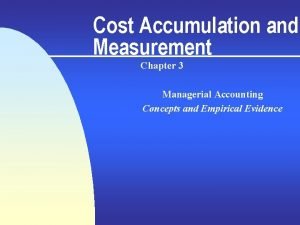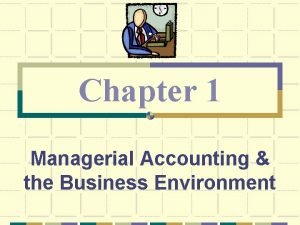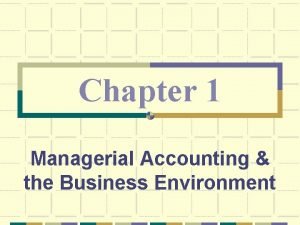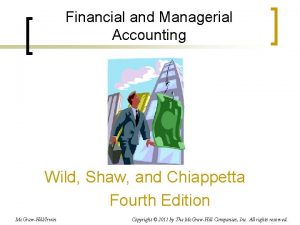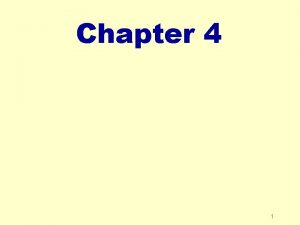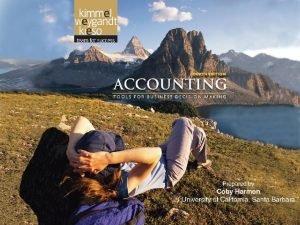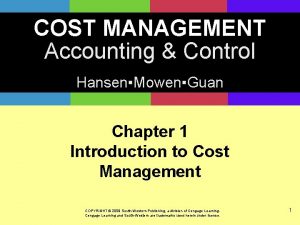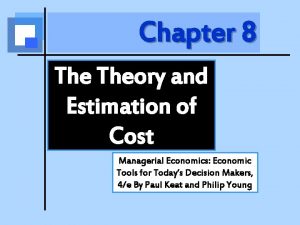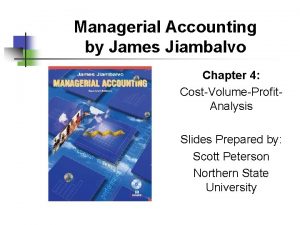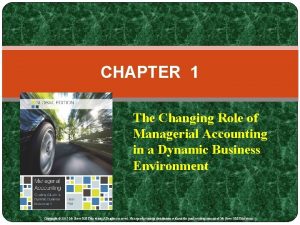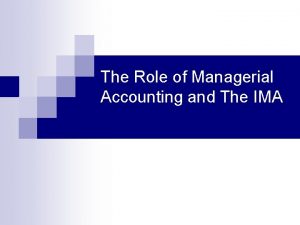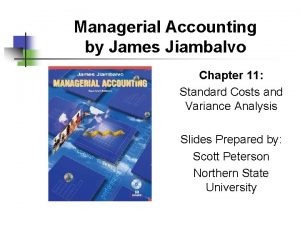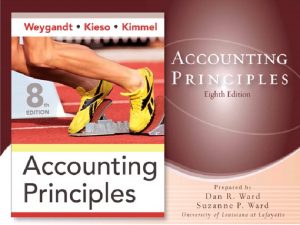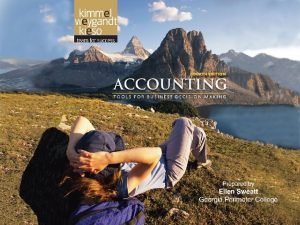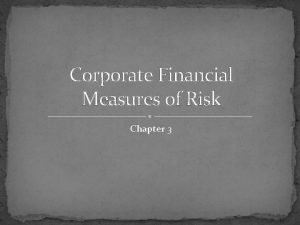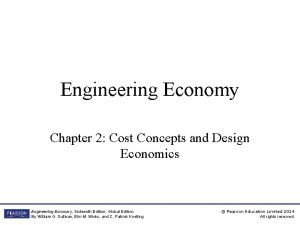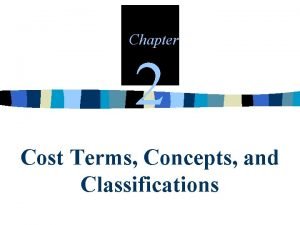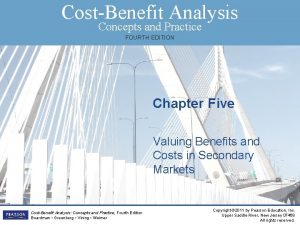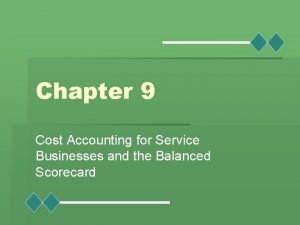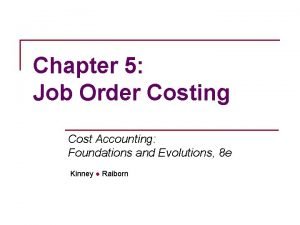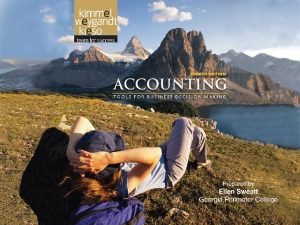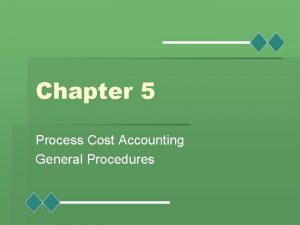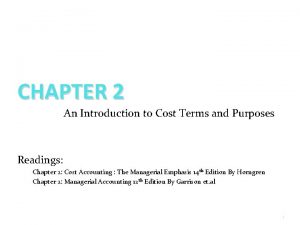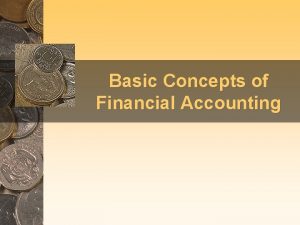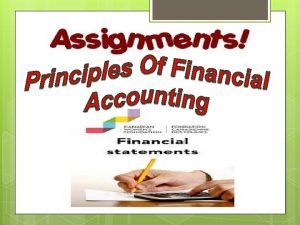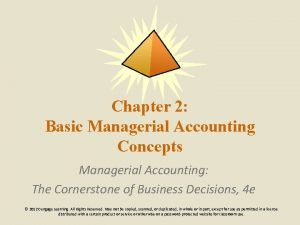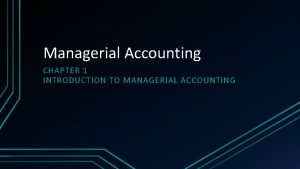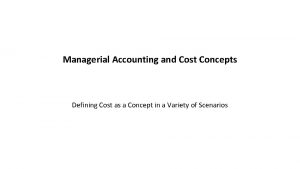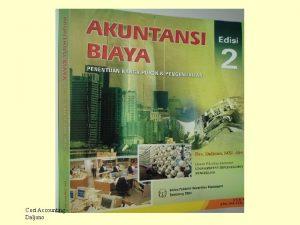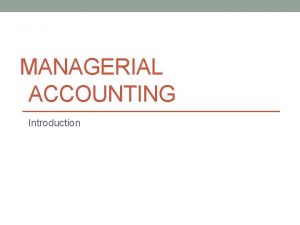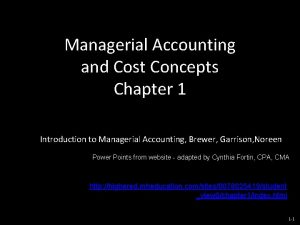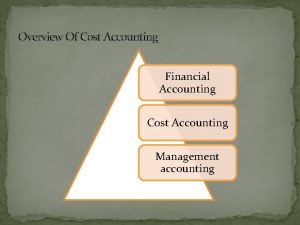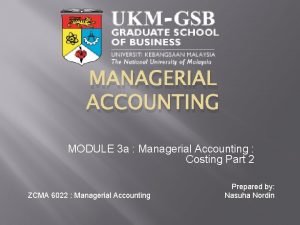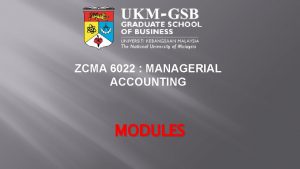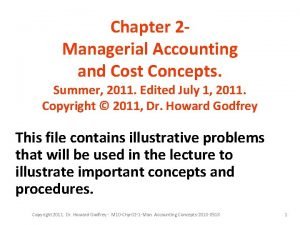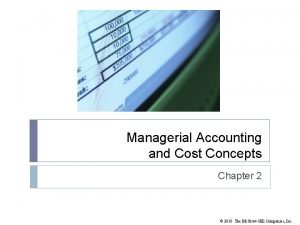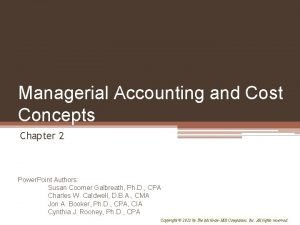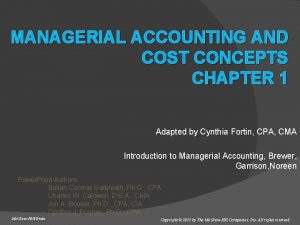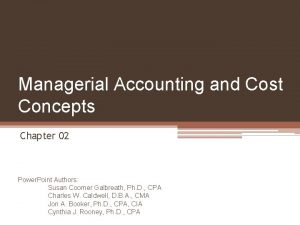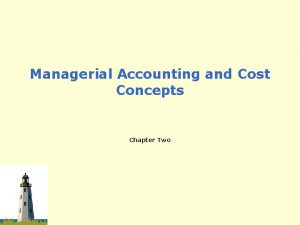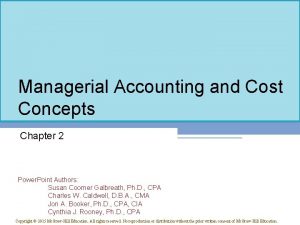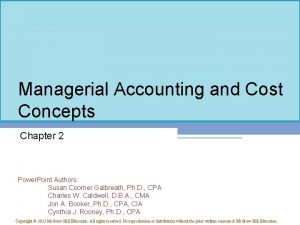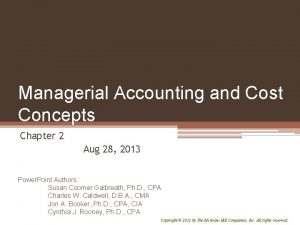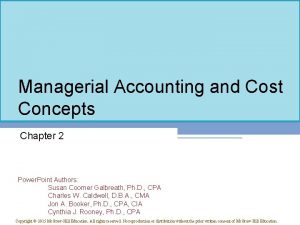Managerial Accounting and Cost Concepts Chapter 1 Introduction



















































- Slides: 51

Managerial Accounting and Cost Concepts Chapter 1 Introduction to Managerial Accounting, Brewer, Garrison, Noreen Power Points from website - adapted by Cynthia Fortin, CPA, CMA http: //highered. mheducation. com/sites/0078025419/student _view 0/chapter 1/index. html 1 -1

Summary of cost classifications 1 -2

Purposes of Cost Classification 1. Assigning costs to cost objects 2. Accounting for costs in manufacturing companies 3. Preparing financial statements 4. Predicting cost behavior in response to changes in activity 5. Making decisions 1 -3

Like different knives different purposes Types of costs vary depending on situation Different costs Different purposes 1 -4

Classifications of Manufacturing Costs Direct Materials Direct Labor Manufacturing Overhead 1 -5

Manufacturing cost categories Direct Materials (DM) Raw materials • Teardown image of Apple’s i. Phone X 1 -6

Direct materials Plastic Steel Wood 1 -7

Manufacturing cost categories Direct Labor (DL) Assembly line workers 1 -8

Manufacturing cost categories Manufacturing overhead Also known as burden – Electricity – Depreciation – Property taxes – Materials - minor parts / material – solder, washers, grease 1 -9

Manufacturing overhead Indirect Labor examples • Forklift truck operators • Janitors • • Security Rework labor (fix defects) Overtime premium paid to ALL workers Manager’s salaries 1 -10

Direct Cost Easily traced to it. Inner lining (Cotton and polyester Trace Football 1 -11

1 -12

Indirect Costs (manufacturing overhead) • Cannot be easily traced to the cost object. • Allocated to cost objects 1 -13

Nonmanufacturing Costs Administrative Costs All executive, organizational, and clerical costs. 1 -14

Product Costs • Capitalized on the balance sheet (inventory) • Expensed only when the product sold For example: –Direct labor –Direct materials –Overhead 1 -15

Period Costs • Expensed on the income statement as they are incurred Selling, general and administrative costs 1 -16

Product Costs Versus Period Costs Product costs Cost of Good Sold Inventory Period costs Expense Sale Balance Sheet Income Statement 1 -17

Quick Check Which of the following costs would be considered a period rather than a product cost in a manufacturing company? A. Manufacturing equipment depreciation. B. Property taxes on corporate headquarters. C. Direct materials costs. D. Electrical costs to light the production facility. E. Sales commissions. 1 -18

Quick Check Which of the following costs would be considered a period rather than a product cost in a manufacturing company? A. Manufacturing equipment depreciation. B. Property taxes on corporate headquarters. C. Direct materials costs. D. Electrical costs to light the production facility. E. Sales commissions. 1 -19

Classifications of Costs Manufacturing costs are often classified as follows: Direct Material Direct Labor Prime Cost Manufacturing Overhead Conversion Cost 1 -20

Predicting Cost Behavior Changes in activity create a reaction ▫ Variable costs -> Change 1. ▫ Fixed costs => same 2. ▫ Mixed costs => change 3. how a cost will react to changes such as sales volume, production volume, or orders processed. 1 -21

Fixed cost example What would be the cost per student if two students bought this delicious fish dish? ¥ 45 45 RMB What if four students ordered the dish? 1 -22

Variable costs example a beverage costs 10 RMB and each student eating the fish has one beverage Fixed cost: Fish 45 Variable costs: 4 drinks @ 10 RMB 40 1 -23

Cost behavior patterns Variable Cost • Constant per unit (beverage) but changes in total in proportion to changes in the cost driver (activity) within the relevant range $ Volume • Examples Materials (parts), fuel costs for a trucking company, line employee wages 1 -24

Cost behavior patterns Fixed Cost n n n A cost which constant in total as volume changes but changes on a per-unit (fish) basis as the cost driver increases and decreases within the relevant range Such as depreciation, insurance, real estate taxes, supervisor salary $ Volume 1 -25

Activity Base (Cost Driver) Machinehours Units produced What drives cost to change? Kilometers driven Laborhours 1 -26

Types of Fixed Costs Committed Long term, cannot be significantly reduced in the short term. 1 -27

Types of Fixed Costs Discretionary May be altered in the short term by current managerial decisions Advertising Research and Development 1 -28

Relevant Range Major Assumptions • • • Costs => variable and fixed Specific Time Span Linear Total Cost Relationship Only one cost driver Variations of the cost driver are within the relevant range 1 -29

Relevant Range Major Assumptions • • • Costs => variable and fixed Specific Time Span Linear Total Cost Relationship Only one cost driver Variations of the cost driver are within the relevant range 1 -30

Relevant Range The relevant range is the range of activity within which assumptions about variable and fixed cost behavior are valid. 1 -31

Relevant Range and Cost Behavior $ Relevant Range Volume Variable Cost $ Relevant Range Volume Fixed Cost 1 -32

Fixed Costs and the Relevant Range Assume office space is available at a rental rate of $30, 000 per year in increments of 1, 000 square feet. Fixed costs would increase in a step fashion at a rate of $30, 000 for each additional 1, 000 square feet. 1 -33

Rent Cost in Thousands of Dollars Fixed Costs and the Relevant Range 90 Relevant 60 Range 30 0 0 Range of activity over which the graph of the cost is flat. 1, 000 2, 000 3, 000 Rented Area (Square Feet) 1 -34

Predicting Cost Behavior 1 -35

Quick Check Which of these costs change (variable) with the number of ice cream cones sold at a Baskins & Robbins shop? (There may be more than one correct answer. ) A. The cost of lighting the store. B. The wages of the store manager. C. The cost of ice cream. D. The cost of napkins for customers. 1 -36

Quick Check Which of the following costs would be variable with respect to the number of cones sold at a Baskins & Robbins shop? (There may be more than one correct answer. ) A. The cost of lighting the store. B. The wages of the store manager. C. The cost of ice cream. D. The cost of napkins for customers. 1 -37

Mixed Costs (or semivariable costs) Contains both variable and fixed elements Total Utility Cost Y l a t o ed x i m t s o c T Variable Cost per KW Activity (Kilowatt Hours) X Fixed Monthly Utility Charge 1 -38

Mixed Costs Total Utility Cost Y l a t o ed x i m t s o c T Variable Cost per KW Activity (Kilowatt Hours) X Fixed Monthly Utility Charge 1 -39

Mixed Costs – An Example If your fixed monthly utility charge is $40, your variable cost is $0. 03 per kilowatt hour, and your monthly activity level is 2, 000 kilowatt hours, what is the amount of your utility bill? 1 -40

Cost behaviour pattern • Cost behavior patterns refer to how business and operating expenses change or remain stable through different events. • Patterns can change especially during varying production levels or sales volume within the company. • Cost behavior patterns occur in fixed, variable and mixed expenses. 1 -41

1 -42

Different Types of Profit Firms • Merchandising-sector companies – Product resellers • Manufacturing-sector companies – Create and sell their own products - BMW • Service-sector companies – Provide services / intangible products For ex. : legal advice, auditors. 1 -43

Income statement formats Used primarily for external reporting. 1 -44

Uses of the Contribution Format The contribution income statement format is used as an internal planning and decision-making tool. We will use this approach for: 1. Cost-volume-profit analysis (Chapter 5). 2. Budgeting (Chapter 7). 3. Segmented reporting of profit data (Chapter 6). 4. Special decisions such as pricing and make-orbuy analysis (Chapter 10). 1 -45

Costs for Decision Making Every decision choice between at least two alternatives. 1 -46

Only consider costs that differ between alternatives 1 -47

Differential Cost and Revenue Example: You have a job paying $1, 500 per month in your hometown. You have a job offer in a neighboring city that pays $2, 000 per month. The commuting cost to the city is $300 per month. Differential revenue is: $2, 000 – $1, 500 = $500 Differential cost is: $300 1 -48

Opportunity Cost Benefit given up when one alternative is selected over another. Example: If you were not attending college, you could be earning $15, 000 per year. Your opportunity cost of attending college for one year is $15, 000. Cost of not enjoying the benefit of earning a salary 1 -49

Sunk Costs Already incurred and cannot be changed now or in the future. Ignore when making decisions. 1 -50

Summary of the Types of Cost Classifications Financial Reporting Product vs Period Assigning Costs to Cost Objects Direct, Indirect Predicting Cost Behavior Fixed, Variable, Mixed Making Business Decisions Differential, Sunk, Opportunity 1 -51
 Managerial accounting and cost concepts
Managerial accounting and cost concepts Chapter 1 managerial accounting and cost concepts
Chapter 1 managerial accounting and cost concepts Managerial accounting and cost concepts
Managerial accounting and cost concepts Managerial accounting concepts and principles
Managerial accounting concepts and principles Basic management accounting concepts
Basic management accounting concepts Focus of managerial accounting
Focus of managerial accounting Introduction to managerial accounting ppt
Introduction to managerial accounting ppt Definition of cost concept
Definition of cost concept Managerial accounting chapter 5
Managerial accounting chapter 5 Managerial accounting chapter 13 solutions
Managerial accounting chapter 13 solutions Managerial accounting chapter 9
Managerial accounting chapter 9 Managerial accounting chapter 2 solutions
Managerial accounting chapter 2 solutions Chapter 6 managerial accounting solutions
Chapter 6 managerial accounting solutions Managerial accounting chapter 7
Managerial accounting chapter 7 Chapter 1 managerial accounting
Chapter 1 managerial accounting Methods of cost estimation in managerial economics
Methods of cost estimation in managerial economics Chapter 1 managerial accounting
Chapter 1 managerial accounting Managerial accounting chapter 3
Managerial accounting chapter 3 Analyzing transactions in accounting
Analyzing transactions in accounting The fundamental concept of managerial economics
The fundamental concept of managerial economics What is discounting principle
What is discounting principle Financial and managerial accounting weygandt kimmel kieso
Financial and managerial accounting weygandt kimmel kieso Accounting and the business environment
Accounting and the business environment Managerial accounting and the business environment
Managerial accounting and the business environment Wild financial and managerial accounting
Wild financial and managerial accounting Accrual accounting concept
Accrual accounting concept Accrual accounting principles
Accrual accounting principles Introduction and mathematical concepts
Introduction and mathematical concepts Cost and management accounting chapter 1
Cost and management accounting chapter 1 Intermediate accounting chapter 1
Intermediate accounting chapter 1 Estimation of cost function in managerial economics
Estimation of cost function in managerial economics The scope of management accounting includes
The scope of management accounting includes Jiambalvo managerial accounting
Jiambalvo managerial accounting Role of managerial accounting
Role of managerial accounting Managerial accounting
Managerial accounting Managerial accounting james jiambalvo
Managerial accounting james jiambalvo Management accounting
Management accounting Manufacturing accounting basics
Manufacturing accounting basics Distinguishing features of managerial accounting
Distinguishing features of managerial accounting Dol managerial accounting
Dol managerial accounting Cost concepts and design economics
Cost concepts and design economics Cost terms concepts and classifications
Cost terms concepts and classifications Cost-benefit analysis concepts and practice
Cost-benefit analysis concepts and practice Cost accounting chapter 9
Cost accounting chapter 9 Job cost sheet
Job cost sheet Process costing steps
Process costing steps Cost accounting chapter 5
Cost accounting chapter 5 An introduction to cost terms and purposes
An introduction to cost terms and purposes Basic concepts of accounting and finance
Basic concepts of accounting and finance What do you mean by accounting
What do you mean by accounting Accounting principles
Accounting principles Introduction to accounting and business
Introduction to accounting and business
